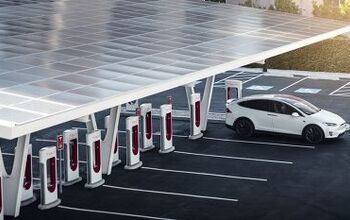Does Efficiency-Per-Performance Matter?
We’ve already been impressed enough with the McLaren MP4-12C’s 3.8 liter turbocharged V8 to say it “looks like mechanical sex” and give it its own gallery. The super-compact, direct-injected engine develops in the neighborhood of 600 hp, giving the new McLaren the dangly bits to show a (similarly-priced) Ferrari 458 the way around a racetrack. And though McLaren clearly thinks the MP4-12C’s race-tested abilities will help build its brand into the new race-nerd standard, it’s also beating Ferrari at a new game that will become increasingly important with time: the C02-per-horsepower game. Ferrari’s 570 hp V8 emits 320 grams of C02 per kilometer, giving the Fezza a rating of .56 grams of C02 per km per horsepower. McLaren’s goal for its not-quite finalized MP4-12C drivetrain is a C02 emissions rating of below 300 gm per km, which would give the supercar closer to a .5 gram per km per horsepower rating. And though the direct-injected, downsized and turbocharged engine helps keep that number down, the MP4-12C’s dry weight is also 176 lbs lighter than the 458’s (2,866 versus 3,042).
And McLaren isn’t alone in pushing the limits of power-per-carbon. BMW’s forthcoming Efficient Dynamics supercar will reportedly offer M6 performance (500 hp) with a third of the carbon emission of the V10-powered M6, giving it a projected C02 per km per hp figure of .454, although unlike the 458 and MP4-12C, it will meet that goal using electric engines powered by a three-pot diesel engine. Like Porsche’s 918, the Efficient Dynamics is part of the next-generation of sportscars that leaves pure-gas drivetrains behind. The future of efficiency-per-performance looks good, but only when measured in carbon. Meanwhile, the fact that BMW’s switch to a hybrid-electric drivetrain will only reduce C02 by as much as McLaren was able to improve on Ferrari’s design through downsizing, direct-injection, turbocharging and weight reduction shows how much more efficient all gas engines can be.
But here’s the real question: does carbon-per-horsepower matter? After all, 300 gm per km is still over twice the EU’s 2015 average emissions goal. The MP4-12C is no “green car,” but if you assume that supercars will continue to exist, the relationship between power and efficiency will become a more important measure over time. After all, a 89 g/km Prius breaks down to .66 grams per km per horsepower, worse even than the 458. If this new relativist perspective doesn’t take hold, government regulations will eventually become strict enough to force certain levels of performance into the realm of electric vehicles or complex hybrids. The Efficient Dynamics and 918 show that this isn’t the end of the world, but for now the MP4-12C is looking like one of the most accomplished of what may be the last generation of pure-gas supercars. Whether this technical achievement translates into brand equity and sales, however, is an entirely different question.
More by Edward Niedermeyer
Latest Car Reviews
Read moreLatest Product Reviews
Read moreRecent Comments
- MaintenanceCosts "And with ANY car, always budget for maintenance."The question is whether you have to budget a thousand bucks (or euro) a year, or a quarter of your income.
- FreedMike The NASCAR race was a dandy. That finish…
- EBFlex It’s ironic that the typical low IQ big government simps are all over this yet we’re completely silent when oil companies took massive losses during Covid. Funny how that’s fine but profits aren’t. These people have no idea how business works.
- Ajla Goldman Sachs 🥂
- Rna65689660 DVR and watch all that are aired. Has been this way for 40 years.


































Comments
Join the conversation
Why does CO2 per hp matter? One, it's a direct measurement of fuel efficiency, so it doesn't really differ from L/100km or MPG save for it's measuring hydrocarbons on the way out. So other than feel-goodness it's kind irrelevant as well already have a fuel usage yardstick. I'm not a chemist, so maybe I'm missing something, I don't see why this would be useful unless you're going to replace fuel usage metrics we already have. Second, and this concerns me, wouldn't this lead to gaming of the system by favouring learn-burn? Assuming you could get by emissions regulations for NOx?
WTF? What a meaningless metric this is. Why hp and not say top speed, weight or vehicle cost. Multiplying the CO2/Km by the average distance driven might come down legitimately in the favour of a super-car. but CO2 /hp is ridiculous, by this measure a top fuel dragster might be fairly frugal given they use nitromethane not petrol (different stoicometric). While we're at it express the average distance driven in furlongs to maintain the mish-mash of SI and Imperial units.